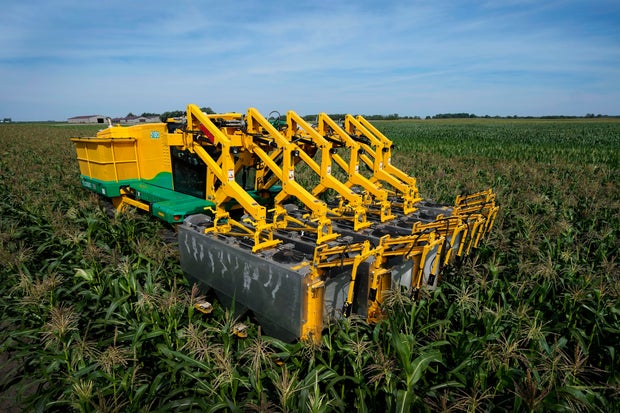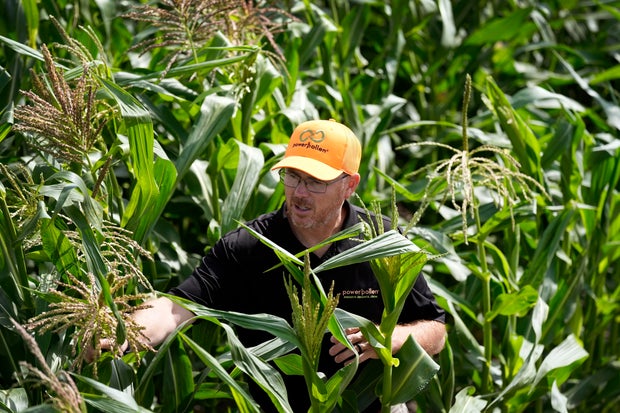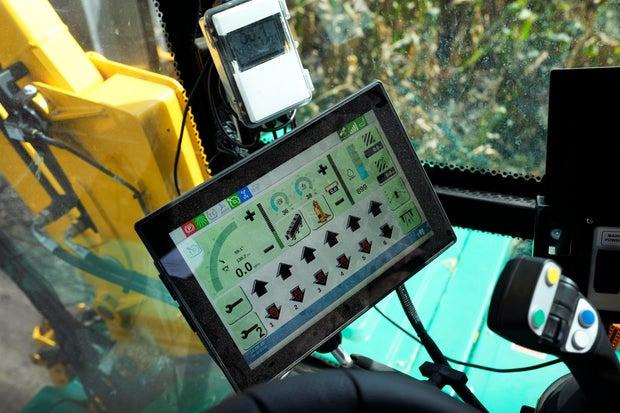CBS News
Biden to cast early vote for president in Delaware with Election Day over a week away

Washington — President Biden will cast his early vote Monday with just over a week to go until Election Day, as his chosen successor and former rival appear to be deadlocked in a tight race for the White House.
Mr. Biden will cast his vote in Wilmington, Delaware, where he spent the weekend, before returning to the White House.
The moment comes four years to the day after Mr. Biden cast his vote in the 2020 race and would go on to win the most votes ever cast for a U.S. presidential candidate. This year, the president casts his ballot months after opting to abandon his reelection bid and leave the presidential race, endorsing Vice President Kamala Harris for the Democratic nomination.
Chip Somodevilla/Getty Images
Since he dropped out of the race, the president has largely stayed off the campaign trail and often out of the spotlight, giving voters a chance to get to know his possible successor. Meanwhile, Harris has worked to toe a narrow line — aligning herself with the Biden administration’s successes, while distinguishing herself from pain points with voters.
Harris and former President Donald Trump are tied across the battleground states, while Harris has a one-point lead nationally, according to a CBS News poll released Sunday.
CBS News
3 ways HELOC interest rates could drop this November

Getty Images
If you’ve been contemplating borrowing money via your home equity, now could be a good time to act. While interest rates are at record highs on credit cards and personal loan interest are rates approaching 13% right now, rates on a home equity loan or home equity line of credit (HELOC) are still in the single digits. And rates on both products are on the decline and likely to fall further in November. This is especially true for HELOCs, which have variable interest rates subject to change monthly based on market conditions. That’s a distinct disadvantage in the rate climate borrowers have lived through in recent years but is now a major boost as interest rates are falling again.
If you’re considering a HELOC, in particular, which works as a revolving line of credit similar to credit cards, you’re likely in luck. There are multiple ways in which HELOC interest rates could drop again in November. Below, we’ll detail three of them.
Start by seeing what HELOC interest rate you can qualify for here.
3 ways HELOC interest rates could drop in November
Here are three separate ways HELOC interest rates, currently at an average of 8.69%, could drop even further in the new month:
Unemployment could fall again
The first day of the new month could be an indicator of positive rates news. Encouraging unemployment data released on November 1 showing an addition of more jobs and a drop in the unemployment rate, could spark a reduction in HELOC interest rates. This data is often used as a measurement of economic health. A lower number here, then, could encourage the Fed to keep cutting interest rates. Knowing this, lenders may start reducing their HELOC offers.
Get started with a HELOC online now.
The Fed could cut rates again
This is the most obvious way HELOC rates could fall again and it could occur after the next Federal Reserve meeting on November 7. The Fed’s first rate cut of 2024 in September caused HELOC rates to decline, so another one issued here will likely do the same, possibly even before the Fed makes it official as some lenders will price in these presumed rate cuts in advance. The CME FedWatch tool says there’s a 98% chance the Fed will cut its federal funds rate by 25 basis points at this meeting. And if the unemployment data released on the first Friday of the month is encouraging, that 98% chance could become a virtual certainty.
Inflation could continue to decline
Borrowers will need to wait for mid-November to get the next inflation reading, but if the one that comes out on November 13 is yet another encouraging one, it could lead to lenders preemptively lowering rates on borrowing products like HELOCs. After an uneven start to 2024, inflation has been consistently cooling in recent months. Another decline for October (reported in November) could be further proof to a “soft landing,” encouraging lenders to loosen up borrowing again via lower rates.
Learn more about today’s HELOC interest rates here.
The bottom line
HELOC interest rates are falling and are likely to fall again in November. With the next Federal Reserve meeting, unemployment report and inflation data all slated for a 13-day span in the first half of the month, there will be enough data to encourage lenders to again lower rates. That said, waiting for interest rates to fall is an inherently risky strategy, so if you know you need to borrow from your home and you want to do so with a HELOC, it makes sense to act now. Rates on these products will adjust independently each month anyway, so if rates fall after you’ve opened one, you’ll still be able to take advantage without having to refinance or take any additional action.
CBS News
How to qualify for a credit card hardship program this November

Getty Images
As we head into November, many Americans are feeling financial strain caused by carrying a credit card balance from one month to the next. After all, credit cards are one of the most expensive financing options, with the average credit card interest rate now exceeding 23% — the highest rate on record. That, coupled with the compounding nature of credit card interest, has resulted in significant financial strain for millions of cardholders.
Another issue is that many households continue to feel the lingering effects of inflation on the prices of everyday essentials, despite significant improvements in the inflation rate. This economic pressure has led more people to rely on credit cards to bridge the financial gaps they’re facing. The average person now carries nearly $8,000 in credit card debt, and given how quickly the interest charges can compound, many cardholders are searching for solutions to their escalating debts.
For those facing unexpected financial hardships, a credit card hardship program may be the right move. These assistance programs can provide substantial relief by temporarily reducing interest rates, waiving card fees or lowering monthly payments. However, they’re not automatically available to everyone — and you must meet specific qualification criteria to enroll.
Learn about your credit card debt relief options here.
How to qualify for a credit card hardship program this November
If you’re considering applying for a credit card hardship program, here’s how to get started:
Identify your financial hardship
Hardship programs are typically designed to assist people who are facing genuine, verifiable financial difficulties, like a recent job loss, high medical bills, a reduction in income or other unexpected events. So before reaching out to your card issuer, take the time to gather documents that support your situation, such as termination notices, hospital or doctor’s bills, pay stubs showing reduced hours or bank statements that highlight financial strain. Being transparent and specific about your financial challenges will make your request more compelling.
Get rid of your high-rate credit card debt now.
Have your financial information ready
You should also be prepared to provide a clear and detailed picture of your current financial situation. This might include a summary of your monthly income, expenses and any other debts you’re managing. Some issuers will request specific forms of documentation, such as recent pay stubs, tax returns or a monthly budget breakdown. Presenting accurate and organized information can strengthen your case and make it easier for the issuer to understand why you need assistance.
Contact your card issuer
Not all credit card companies offer hardship programs, and the terms can vary significantly among those that do. Some issuers may only provide short-term assistance, while others offer longer periods of relief. In order to determine what’s available to you, call the customer service number on the back of your card and ask to speak with someone about financial hardship assistance. Make sure to ask specific questions about eligibility requirements, program terms and the documentation you’ll need to submit.
Demonstrate a willingness to pay
Issuers are more inclined to offer assistance to customers who show a history of responsible debt management. If possible, highlight your past efforts to make timely payments, even if they were partial or occasionally delayed. If you’re experiencing a temporary setback, make sure your lender knows you are committed to paying down your debt once your situation improves. A willingness to work toward repayment, even in small amounts, can improve your chances of being approved for a hardship program.
Apply promptly
Applying promptly, especially if your financial issues are worsening, can increase your chances of securing assistance. Credit card companies sometimes adjust their hardship programs based on the economic climate and customer demand, so reaching out sooner rather than later can give you a better shot at getting approved before stricter criteria or limited availability impact your chances.
What to do if you don’t qualify
If you’re not approved for a credit card hardship program, don’t lose hope. Other debt relief options may still be accessible to you. Here are a few alternative strategies to consider:
- Credit card debt forgiveness: Credit card debt forgiveness, also referred to as debt settlement, is a process in which you work with a debt settlement company or negotiate directly with your creditors to try and settle your debt for less than what you owe.
- Debt consolidation: Debt consolidation allows you to combine multiple credit card balances into a single loan, ideally with a lower interest rate, to simplify your payments and potentially reduce the amount of interest you’re paying each month.
- Debt management: A debt management plan helps you pay off credit card debt with structured monthly payments over three to five years. These programs may offer reduced interest rates or waived fees, making monthly payments more affordable.
The bottom line
Credit card hardship programs can be a valuable tool for those who qualify, so if you’re facing a temporary financial setback, it may be worth considering this option. But if you don’t qualify, other debt relief solutions may provide the help you need. By exploring the options above and speaking with a debt relief expert, you may be able to find a pathway to reduce your debt burden this November and work toward long-term financial stability.
CBS News
Automation in agriculture offers solutions for farmers, but workers fear for their jobs

As a mist of rain sprinkled the fields around him in Homestead, Florida, Ford bemoaned how expensive it had been running a fossil fuel-powered irrigation system on his five-acre farm — and how bad it was for the planet.
Earlier this month, Ford installed an automated underground system that uses a solar-powered pump to periodically saturate the roots of his crops, saving “thousands of gallons of water.” Although they may be more costly up front, he sees such climate-friendly investments as a necessary expense — and more affordable than expanding his workforce of two.
It’s “much more efficient,” said Ford. “We’ve tried to figure out ‘How do we do it?’ with the least amount of adding labor.”
A growing number of companies are bringing automation to agriculture. It could ease the sector’s deepening labor shortage, help farmers manage costs, and protect workers from extreme heat. Automation could also improve yields by bringing greater accuracy to planting, harvesting, and farm management, potentially mitigating some of the challenges of growing food in an ever-warmer world.
But many small farmers and producers across the country aren’t convinced. Barriers to adoption go beyond steep price tags to questions about whether the tools can do the jobs nearly as well as the workers they’d replace. Some of those same workers wonder what this trend might mean for them, and whether machines will lead to exploitation.
Charlie Neibergall / AP
How autonomous is farm automation? Not completely – yet
On some farms, driverless tractors churn through acres of corn, soybeans, lettuce and more. Such equipment is expensive, and requires mastering new tools, but row crops are fairly easy to automate. Harvesting small, non-uniform and easily damaged fruits like blackberries, or big citruses that take a bit of strength and dexterity to pull off a tree, would be much harder.
That doesn’t deter scientists like Xin Zhang, a biological and agricultural engineer at Mississippi State University. Working with a team at Georgia Institute of Technology, she wants to apply some of the automation techniques surgeons use, and the object recognition power of advanced cameras and computers, to create robotic berry-picking arms that can pluck the fruits without creating a sticky, purple mess.
The scientists have collaborated with farmers for field trials, but Zhang isn’t sure when the machine might be ready for consumers. Although robotic harvesting is not widespread, a smattering of products have hit the market, and can be seen working from Washington’s orchards to Florida’s produce farms.
“I feel like this is the future,” Zhang said.
But where she sees promise, others see problems.
Frank James, executive director of grassroots agriculture group Dakota Rural Action, grew up on a cattle and crop farm in northeastern South Dakota. His family once employed a handful of farmhands, but has had to cut back due, in part, to the lack of available labor. Much of the work is now done by his brother and sister-in-law, while his 80-year-old father occasionally pitches in.
They swear by tractor autosteer, an automated system that communicates with a satellite to help keep the machine on track. But it can’t identify the moisture levels in the fields which can hamstring tools or cause the tractor to get stuck, and requires human oversight to work as it should. The technology also complicates maintenance. For these reasons, he doubts automation will become the “absolute” future of farm work.
“You build a relationship with the land, with the animals, with the place that you’re producing it. And we’re moving away from that,” said James.
Charlie Neibergall / AP
Some farmers say automation answers labor woes
Tim Bucher grew up on a farm in Northern California and has worked in agriculture since he was 16. Dealing with weather issues like drought has always been a fact of life for him, but climate change has brought new challenges as temperatures regularly hit triple digits and blankets of smoke ruin entire vineyards.
The toll of climate change compounded by labor challenges inspired him to combine his farming experience with his Silicon Valley engineering and startup background to found AgTonomy in 2021. It works with equipment manufacturers like Doosan Bobcat to make automated tractors and other tools.
Since pilot programs started in 2022, Bucher says the company has been “inundated” with customers, mainly vineyard and orchard growers in California and Washington.
Those who follow the sector say farmers, often skeptical of new technology, will consider automation if it will make their business more profitable and their lives easier. Will Brigham, a dairy and maple farmer in Vermont, sees such tools as solutions to the nation’s agricultural workforce shortage.
“A lot of farmers are struggling with labor,” he said, citing the “high competition” with jobs where “you don’t have to deal with weather.
Since 2021, Brigham’s family farm has been using Farmblox, an AI-powered farm monitoring and management system that helps them get ahead of issues like leaks in tubing used in maple production. Six months ago, he joined the company as a senior sales engineer to help other farmers embrace technology like it.”
Workers worry about losing jobs, or their rights, to automation
Detasseling corn used to be a rite of passage for some young people in the Midwest. Teenagers would wade through seas of corn removing tassels – the bit that looks like a yellow feather duster at the top of each stalk – to prevent unwanted pollination.
Extreme heat, drought and intense rainfall have made this labor-intensive task even harder. And it’s now more often done by migrant farmworkers who sometimes put in 20-hour days to keep up. That’s why Jason Cope, co-founder of farm tech company PowerPollen, thinks it’s essential to mechanize arduous tasks like detasseling. His team created a tool a tractor can use to collect the pollen from male plants without having to remove the tassel. It can then be saved for future crops.
“We can account for climate change by timing pollen perfectly as it’s delivered,” he said. “And it takes a lot of that labor that’s hard to come by out of the equation.
Charlie Neibergall / AP
Workers worry about losing jobs, or their rights, to automation
Detasseling corn used to be a rite of passage for some young people in the Midwest. Teenagers would wade through seas of corn removing tassels – the bit that looks like a yellow feather duster at the top of each stalk – to prevent unwanted pollination.
Extreme heat, drought and intense rainfall have made this labor-intensive task even harder. And it’s now more often done by migrant farmworkers who sometimes put in 20-hour days to keep up. That’s why Jason Cope, co-founder of farm tech company PowerPollen, thinks it’s essential to mechanize arduous tasks like detasseling. His team created a tool a tractor can use to collect the pollen from male plants without having to remove the tassel. It can then be saved for future crops.
“We can account for climate change by timing pollen perfectly as it’s delivered,” he said. “And it takes a lot of that labor that’s hard to come by out of the equation.”
Workers worry about losing jobs, or their rights, to automation
Detasseling corn used to be a rite of passage for some young people in the Midwest. Teenagers would wade through seas of corn removing tassels – the bit that looks like a yellow feather duster at the top of each stalk – to prevent unwanted pollination.
Extreme heat, drought and intense rainfall have made this labor-intensive task even harder. And it’s now more often done by migrant farmworkers who sometimes put in 20-hour days to keep up. That’s why Jason Cope, co-founder of farm tech company PowerPollen, thinks it’s essential to mechanize arduous tasks like detasseling. His team created a tool a tractor can use to collect the pollen from male plants without having to remove the tassel. It can then be saved for future crops.
“We can account for climate change by timing pollen perfectly as it’s delivered,” he said. “And it takes a lot of that labor that’s hard to come by out of the equation.”
Erik Nicholson, who previously worked as a farm labor organizer and now runs Semillero de Ideas, a nonprofit focused on farmworkers and technology, said he has heard from farm workers concerned about losing work to automation. Some have also expressed worry about the safety of working alongside autonomous machines but are hesitant to raise issues because they fear losing their jobs. He’d like to see the companies building these machines, and the farm owners using them, put people first.
Luis Jimenez, a New York dairy worker, agrees. He described one farm using technology to monitor cows for sicknesses. Those kinds of tools can sometimes identify infections sooner than a dairy worker or veterinarian.
They also help workers know how the cows are doing, Jimenez said, speaking in Spanish. But they can reduce the number of people needed on farms and put extra pressure on the workers who remain, he said. That pressure is heightened by increasingly automated technology like video cameras used to monitor workers’ productivity.
Automation can be “a tactic, like a strategy, for bosses, so people are afraid and won’t demand their rights,” said Jimenez, who advocates for immigrant farmworkers with the grassroots organization Alianza Agrícola. Robots, after all, “are machines that don’t ask for anything,” he added. “We don’t want to be replaced by machines.”
Charlie Neibergall / AP
— This story is a collaboration between The Associated Press and Grist. Associated Press reporters Amy Taxin in Santa Ana, California, and Dorany Pineda in Los Angeles contributed. Walling reported from Chicago.














